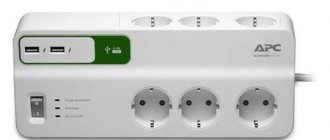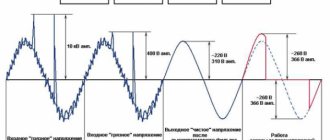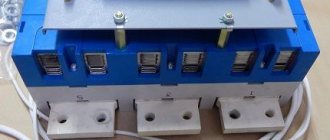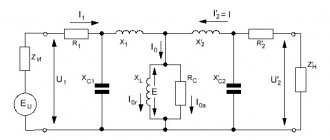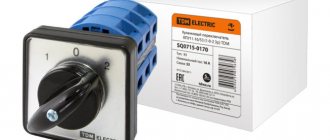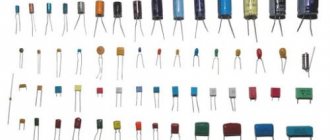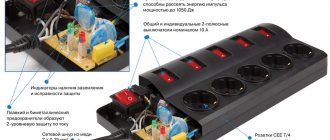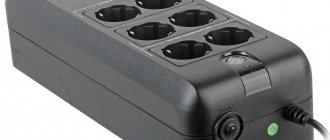The behavior of voltage in a household electrical network is unpredictable. There may be several reasons why the current parameters are outside the permissible deviations. Often these are short-term voltage drops and interference, and sometimes systematic violations of standard standards. The evening voltage in the network differs from the morning one due to the large number of connected devices. Connecting powerful construction or home equipment leads to impulse noise that interferes with the operation of audio and video equipment. The result of temporary and permanent voltage deviations from a sinusoid is deterioration in the quality of work and breakdown of home appliances. One way to avoid trouble is to connect electrical appliances through a surge protector (SF). In simple terms, a surge protector is an extension cord with a toggle switch and a built-in protection unit that provides passive filtering of the input voltage. Let's take a closer look at the design options of different models and the tasks they perform.
What does a surge protector do and what does it protect against?
Problems of the household electrical network that various models of surge protectors struggle with:
- Short circuit. Phase and zero are connected without load. This situation occurs when a wire breaks or a short circuit occurs in any device. In this case, the surge protector turns off all equipment.
- Interference. They arise due to devices connected to the network with switching power supplies. Such equipment includes computers and televisions. High-frequency interference does not damage electronics, but it does degrade its performance. Ripples appear on the screens of analogue TVs, the image is distorted, and extraneous sounds appear in the audio equipment. Extraneous signals distort the operation of sound recording and sound reproducing devices.
- Voltage surges. They can be caused by devices with inductive loads, for example, refrigerators, welding machines.
There is another, unknown to many, danger of interference. Using special equipment, you can gain access to confidential information through electromagnetic noise, which is transmitted through a neutral conductor located outside the house or apartment.
Where is the filter used and what to do if it is not there?
The fact is that in high-quality power supplies it must be installed directly on the board, and even more so on high-power power supplies, such as computer ones. But, unfortunately, your chargers for a smartphone, power supply from a laptop, electronic ballasts of fluorescent and LED lamps most often do not contain them. This is due to the fact that Chinese manufacturers are simplifying the circuits of their devices to reduce their cost. It often happens that there are places on the board for parts whose purpose is to filter interference, but they are simply not soldered and there are jumpers instead. Computer units are a separate issue; almost all of them have the same circuit, but the design is different, and the cheapest models do not have a filter.
You can reduce interference from your TV or other device that you want to protect and improve the properties of its power supply by adding such a filter to a regular power strip. You can assemble it yourself or extract it from a good, but unnecessary or faulty power supply unit.
Finally, we recommend watching a useful video on the topic:
A surge filter is a simple but useful device that will improve the quality of the power supply to your devices and reduce the harm caused to its frequency by the operation of switching power supplies, and the scope is quite wide - use it for any modern equipment. Its design allows even a novice radio amateur to repeat the circuit, and repairs are not difficult. The use of a surge protector is highly desirable for consumers of any kind.
Operating principle of a surge protector
Various types of filters combat factors that distort the ideal appearance of an alternating voltage sinusoid:
- High frequency interference. To eliminate them, inductors are used. If a high-frequency current is supplied to them, the resistance in the coils increases, and the sinusoids of the periods leading to high-frequency interference are cut off. The maximum effect can be achieved by using two coils installed on the phase and neutral wires.
- Low frequency interference. Active resistances - resistors - help combat such interference. Network filters use resistors with a nominal value of 0.5-1.0 Ohm. Usually 2 resistors are installed.
The use of a complex of these filters allows you to get rid of high-frequency and low-frequency interference and, as a result, obtain a sinusoid with a frequency of 50 Hz.
Almost all SFs are equipped with a surge protection function. But surge protectors are needed only in the presence of short-term voltage pulses. They do not protect against prolonged excess of this parameter. If the voltage in a given area is too high or too low for a long time, it is recommended to install a stabilizer, since a surge protector is useless in this case.
How to choose a surge protector for a computer and laptop
Many, when purchasing a laptop, all-in-one computer or desktop computer, do not forget to purchase a pilot filter , and do the right thing. Expensive equipment can break down as a result of network surges, so it must be protected from breakage.
When choosing a filter to protect your laptop and computer, you need to look at such primary points as:
- number of sockets,
- wire length,
- presence of a power button and indicator light.
The standard length is 180 cm, but if you wish, you can look for models with a cord of 3 and 5 m. The longer the cord, the more practical it is to use, and in the office it will be more convenient to have a short cord so that it does not get tangled under your feet.
If the length of the wire turns out to be shorter than what the manufacturer stated, the other qualities of the device may also be questioned, and it is better to refuse to purchase this device.
Of course, the device must be powerful, that is, it must be enough for all the devices that you plan to connect to it.
It will be convenient to have an off and on button so that you don’t have to unplug the cord from the outlet every time, especially if it is located in a hard-to-reach place. The light will indicate whether the device is turned on or not.
There should be enough sockets for all devices: router, printer, monitor, scanner, so that you don’t have to purchase additional extension cords that do not serve as a surge protector. Also check the distance between the sockets - it should be enough to conveniently connect several devices at once.
A mount for wires is also useful; it will be useful if there are a lot of wires and you don’t want them to get tangled. This “item” is optional, but will be convenient to use.
It is worth keeping in mind that no network filter will provide complete protection of your computer from network surges. Only an uninterruptible power supply or voltage stabilizer can cope with such a task.
Device of network filters of different functionality
Cheap SF options are essentially a “carrying device” with surge protection and an “on-off” toggle switch. Overvoltage protection is provided by a varistor.
More expensive surge protector designs include:
- Built-in LC filters, which are inductor coils. Designed to combat high-frequency interference.
- Coils with active resistance - resistors. The presence of these elements in the network filter circuit eliminates low-frequency interference.
- An automatic fuse that cuts off the power supply in case of current overload.
- Metal-oxide varistors, which operate at extremely high voltages, which are possible during a thunderstorm or short circuit.
Standard ratings of used parts:
- The inductance of the coils is 50-200 μH.
- The capacitance of the capacitors is 0.22-1 µF.
- Varistors - designed for voltages up to 470 V.
The circuit may include an overheat sensor that de-energizes the device when the temperature exceeds a set value. The sensor saves the SF from damage in cases where it is located near heating devices or if too high a load is connected to it.
Basic performance characteristics of filters that are important to know
The fight against electromagnetic interference from the network is carried out in different ways. Screen adaptation and the use of electronic components are popular.
Which case combats interference more effectively?
A distinctive feature of high-quality products is a closed metal screen, which eliminates the passage and interference of extraneous electromagnetic signals. It is connected to the ground loop.
In Soviet times, it indicated the diagram of internal connections and technical characteristics of the product.
Such a housing can be made common to the entire device, as is done for a microwave oven or a computer system unit.
Numerous modern modules produced to filter interference from household networks have a conventional plastic casing.
They are deprived of the ability to protect against external interference and extraneous radiation.
In addition, marketers often call ordinary extension cords a surge protector, which is not entirely correct. In this case, their external similarity is used.
Design features and electrical characteristics that improve filtration conditions
Availability of a switch
Marketers pay attention to it by showing small ease of use. It is installed on regular extension cords.
However, this is where his role ends. It simply allows you to turn off or supply power to consumers without pulling the plug from the socket. This function is useful when the socket block is covered by furniture and access to it is difficult.
Permissible load current
I recommend paying close attention to the electrical characteristics declared by the manufacturer. They must be observed.
The load current, for example 10 amperes shown on the case, is the maximum consumption of all connected devices. It cannot be exceeded, because the internal circuit will overheat and insulation damage will occur.
It is important to take into account here that in such a closed structure the thickness of the stranded copper wire does not exceed 1 mm square.
The chokes are made with the same cross-section and act as inductive reactance.
When connecting consumers to filter sockets, it is necessary to calculate the total load current. Quite often a situation arises where it is unacceptable to turn on a vacuum cleaner or kettle in parallel with a running computer.
Filters manufactured in countries with a voltage of 100 or 110 volts (for example, the USA, Japan) may fall into the hands of individual users. They have different pin connectors.
But replacing them with our standard will not allow the use of such devices in our wiring. The entire internal circuit needs to be redone, and this is more expensive than purchasing a new unit.
Main electronic components of the internal circuit
Varistor protection
Even the cheapest designs use one varistor. It stands at the input between the phase and zero potentials. At normal network voltage, it has a very high electrical resistance and does not interfere with the operation of the circuit.
When a residual overvoltage pulse comes from the network, not completely extinguished by the SPD devices, the internal resistance of the varistor sharply decreases.
Due to this, according to Ohm’s law, a large current begins to flow through it, which is converted into thermal energy, and only the permissible voltage level enters the circuit.
Three varistors are used for three-wire wiring. They are turned on to eliminate differential and common-mode voltage noise.
Inductors and capacitors in a high-frequency circuit
The design of the high-frequency filter uses the dependence of capacitive and inductive reactance on the signal frequency.
The usual 50 hertz easily passes through the inductance. For high-frequency interference, a large resistance is created here. Therefore, the windings of the coils are connected in series with the conductors. They are made with the same cross-section as the main wire.
Capacitors are connected in parallel to differential and common-mode noise. Capacitance has an inverse relationship with signal frequency. It shunts high-frequency voltage.
Features of the ferrite ring
It is useful to place a ferrite filter at the ends of the cable a few centimeters from the connector, as is done on a laptop power supply.
Such a passive element in the form of a solid or composite cylinder suppresses RF interference passing through the cable with its inductive reactance.
In this case, depending on the composition of the material and the brand of the ferrite ring, the following occurs:
- reflection of part of the high-frequency interference by inductance back into the network;
- or partial absorption of high-frequency waves by ferrite material (more efficient);
- or a combination of both functions.
The quality of interference suppression by ferrite can be increased. It is enough to pass the cable several times around its ring. However, this is not always possible in practice.
It should be taken into account that interference-absorbing ferrites are not used on multi-core wires of low-current digital data transmission circuits or audio and video signals. They work as an in-phase transformer passing similar signals.
Design features
The main elements of a modern high-quality surge protector:
- Non-flammable PVC plug. Modern devices use ergonomic plugs of improved design, which ensures easy removal from the socket.
- A wire made of three insulated copper cores in a common sheath. At the point where the wire is connected to the housing, there is an elastic coupling that protects the cable from kinks. Wire length – 1.5, 1.8, 3.0, 4.0, 5.0, 10.0 m.
- Frame. Made from wear-resistant ABS plastic. Available in white, light grey, gray colors. The housing contains interference filtering units, a switch, and a thermal breaker. The outlet openings can be equipped with protective curtains that prevent dirt from getting into them. Safety curtains also prevent small children from touching live parts.
Types of switches:
- Are common. Disconnect all sockets of the device from the power supply at once. This option is most common.
- Individual. Disconnect individual outlets.
- Remote controls. SFs with remote controls are rare and are quite expensive. Convenient for people with limited mobility.
Additionally, the design may contain a light indicator, most often connected to a switch. Indicates whether the device is on or off. Some models are equipped with hinges on the back of the case for wall mounting.
Levels of protection provided by filters of different functionality
Conventionally, the SF can be divided into the following groups according to the degree of protection:
- Basic level (Essential). They are inexpensive, structurally simple, and are used to connect inexpensive home appliances. The difference between inexpensive surge protectors and conventional extension cords is that they provide protection against short-term power surges, take the shock and turn off the devices.
- Advanced level (Home/Office). Widely used for devices used at home and in the office. Presented on the market in a wide range.
- Professional level (Perfomence). Such network filters are capable of eliminating all interference, so they are designed for connecting expensive equipment that is sensitive to interference.
Determining the maximum load power
Of course, any SF has its own maximum load rate. This norm is calculated during the creation of the device.
SF can be classified according to 3 parameters. At the same time, each of them has its own strictly defined tasks. Cheap filters are mostly used in the form of extension cords. If the filter is universal, then it can be used for different tasks, and a professional one is used to connect sensitive devices.
The maximum load power is determined by the type of device. Its difference can range from 0.09 kJ to 2.5 kJ and more. The maximum permissible load must be shown on the device packaging in kilowatts. Conventional household filters for the home have this parameter of 2.2 kW. In this case, the current strength is usually 10 A. In addition, there are devices whose rated current has a load of 15 A. They are also designed for modern electrical appliances.
Basic parameters of network filters
SF differ in the cross-section of the supply wires. The most common options are cores with a cross section of 0.75 or 1.0 mm2. Such cross-sections are sufficient to provide a maximum load current of 10 A. If it is necessary to provide a rated current of 16 A, then purchase SF with a core cross-section of 1.5 mm2.
When choosing a device, pay attention to the maximum permissible load power that can be connected. This indicator is equal to the product of the maximum permissible load current and network voltage. Almost any model is suitable to ensure the operation of computers and peripheral devices. But before purchasing a surge protector for household appliances, it is necessary to approximately determine the total power of the devices that you plan to connect. If the total power of the equipment is higher than the power permissible for a given model, then it is not worth buying such a SF.
How to make the right choice
The choice of a surge protector, according to experts, should begin with an external inspection. It must have a mandatory button that allows you to force a network shutdown. A surge protector is a device in which the number of electrical equipment power sockets matters; this depends on the product manufacturer; usually one filter powers several devices of different power.
The correct choice is based on the documents accompanying the product; they reflect all the information necessary for the buyer. The passport must indicate all the functions that the filter has from the manufacturer. Pay attention to the value of the pulse load, it indicates the filter’s ability to withstand significant voltage drops in the network. Some models of surge protectors can withstand the effects of atmospheric discharges on the power source.
Surge filters for offices
For household consumers of electrical energy, the standard length of the device’s power cord is 1.8 m, but there are other options for the cable feeding the filter - 5 m. The presence of different numbers of fuses in the device (but not less than three) should guarantee protection against various types of interference. If the device does not have an LED button, then it is a simple extension cord.
How to choose a surge protector for your computer
Now every family in the cities has a computer; filters have been developed for them that perform the protective function of computer equipment from voltage surges and high frequencies in the network. Users can often visually confuse the filter with another device - a UPS, but the filter functionally protects the PC from overvoltage; it does not support power supply in the event of a network outage, like a UPS.
Surge filters for PC
A surge filter is needed to provide filtering of the network voltage for a computer; it solves the following problems:
- control of impulses passing through it, which can cause the PC to automatically restart without saving data on the monitor;
- ensuring smoothing of high-frequency pulses that occur when powerful consumers are simultaneously turned on.
Experts recommend the APC product to protect their own computer equipment; this device is perfect for home use, as well as in small offices.
Model Surge Arrest Essential
The model has five sockets and is considered inexpensive. The device is average in terms of its main characteristics. It is recommended to connect telephone equipment, fax, and PC through this filter. Cable length - 1.8 m.
Manufacturers also offer better protection - this is the Pilot X-Pro model, which is more resistant to load at high frequency surges. According to the data sheet, the filter of this model absorbs up to 650 J, converting it into heat energy.
Selecting a filter for an LCD TV
The protection of the home theater, as well as other video equipment, is provided by a surge protector for the TV, which must be guaranteed to protect the equipment from interference and voltage surges. Special filters for TVs have an automatic shutdown when a short circuit occurs in the network. Experts recommend the APC PMF83VT-RS filter model for these purposes, which is shown in the photo:
Surge filter variation
This model costs about 3 thousand rubles, has a coaxial input, an indicator, a maximum load current of up to 10 amperes, a power of 2.3 kW, a voltage of 230 volts, has 8 grounded sockets, cable length - 200 cm, the sockets are located on both sides, has protection for TV signal. Each socket can be forcibly turned on or off; there is a general socket switch. Which surge protector to choose is a question that the average person always faces because of the cost of the devices.
There is a cheaper filter option for a TV that costs 1 thousand rubles, this is MOST Elite ERG, pictured:
Surge filter with switching for each outlet
The performance parameters of this filter are the same as in the APC PMF83VT-RS model, but it has only five sockets.
Types of filters
Experts distinguish network filters into three categories, which are determined by their level of protection, namely:
- basic version, essential protection - labeled Essential, recommended for home equipment: microwave, household equipment (vacuum cleaner, iron, other appliances);
- universal filter - marked in the Home/Office passport, recommended for computer equipment, modern LCD TVs;
- Performance category filter, recommended for working with voltage-sensitive equipment, has a fairly high cost.
Ways to improve simple network filter circuits
Radio amateurs can upgrade a surge protector with a switch and varistor by improving its circuitry.
To do this you need:
- open the case;
- Solder resistors R1, R2 and inductive coils (chokes) L1, L2 into parallel branches after the switch and varistor;
- alternately close the branches through capacitor C1 and resistor R3;
- terminal capacitor C2 can be installed between sockets anywhere. If there is no space inside the case, you can do without it. In this case, the parameters of capacitor C1 are adjusted.
Recommendations for choosing parts:
- chokes with open ferrite cores with inductance from 10 μH;
- capacitors – 0.22-1.0 µF;
- resistors - for a load of 500 W, resistors of 0.22 Ohm are used, R3 of at least 500 kOhm.
Schemes for connecting the surge protector to the electrical network
In many modern SF models, the ground wire has no connection with the internal circuit, except for the grounding contacts of Euro sockets and Euro plugs. This is a progressive solution that provides an important advantage. When operating from a grounded network, all SF outlets are grounded as required. If there is no ground in the power outlet, then all the socket outlets are connected to each other via a grounding contact. The surge protector itself is not grounded. Let's consider what can happen with different options for connecting a computer and its peripheral devices:
- Connection to a grounded power supply. This is an ideal option, since if there is a breakdown or damage to the insulation of any of the devices, the “excess” voltage is directed to the ground wire.
- Connection to the network without grounding. In this case, the computer case and peripheral devices are connected only by a low-current interface cable. When a potential difference occurs, equalizing currents appear, which, when flowing from a higher potential to a lower one, lead to combustion of the input and output ports of the devices.
- Connection to the network without grounding via SF with sockets connected via a grounding contact. In this case, the equalizing currents will flow through the grounding contacts of the Euro sockets and the ports will remain unharmed.
Industrial voltage waveform
Strict requirements are placed on frequency. The deviation from the norm does not exceed 0.2 Hz. The relative value is less than 1%. The requirements for single voltage surges are also specified in GOST 54149. Instability interferes with the proper operation of equipment and can lead to failure of a number of devices. A colorful example is the electronic unit of a washing machine, the cost of which is such that repairing the equipment often becomes impractical. It is not surprising that there is always a surge filter at the entrance.
Classic filter type
It is a mistake to think that the purpose of this small element is solely to protect the equipment filling. The surge protector also protects the network from interference. It is not for nothing that in the old manuals for electric tools it was strongly recommended to turn off all digital equipment from the sockets during work, even though a surge protector is invariably included in any drill. The interference from the operation of a commutator motor is so great that it makes sense to play it safe once again.
In the simplest case, flickering (flickering) of lighting fixtures leads to disorders of the nervous system. For digital electronics, sudden surges are dangerous. A surge protector is a device for suppressing all frequencies except 50 Hz. A single device cannot cope with a large range of problems.


